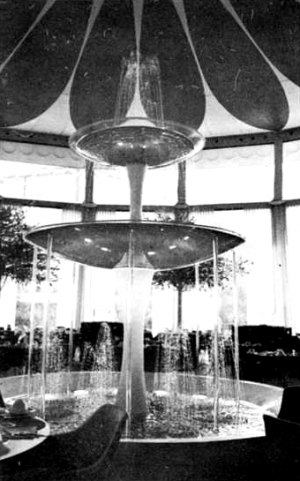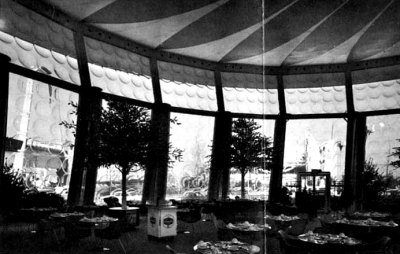|
IN THE DECADES between the two New
York World's Fairs, plastics have become seriously competitive
with natural materials in just about every area imaginable. In
addition, because of superior cost, speed of fabrication and
weight characteristics, they have resulted in the development
of a host of new products and industries.
Every Fair, despite an overall diversity, in retrospect leaves
some distinct impression. The last one held in New York unveiled
commercial television and the first nylon stockings.
This Fair, I believe, demonstrates effectively the present
and believable future of the fabulous world of plastics, a world
that has grown up in the years between "Building the World
of Tomorrow" and "Peace Through Understanding."
Despite its humanistic theme, this Fair will be presenting
its statements in practical terms. In any review of today's environmental
requirements, plastics play an enormously significant part.
Among the exhibits designed by Walter Dorwin Teague Associates
(the American Machine & Foundry Monorail for AMF, the Festival
of Gas Pavilion for the gas industries, and Schaefer Center for
the F. & M. Schaefer Brewing Company), plastics are used
to perform an amazing number of jobs that would have been assigned
to a wide variety of natural materials twenty-five years ago.
In fact, they achieved results and effects that would have been
impossible then. More importantly, they have not been used simply
as substitutes for glass and steel and wood, but rather for their
own new, unique product characteristics and performance. In each
case, interestingly enough, the plastics used offered a solution
to a specific problem which could not have been solved with any
other material.
Sparkling Acrylic Bubble Walls
For the Schaefer Center, designed by us in conjunction with
architects Eggers & Higgins, the requirement was for a semi-permanent,
light weight, inexpensive building. Again, plastics solved several
problems in ways that no other materials could.
Translucent acrylic fountain rests
easily atop glass fiber reinforced plastics base in Schaefer Pavilion.
 |
For the walls, restaurant and exhibit areas, the architects
wanted a transparent, sparkling effect to enclose the two circles,
one 90' in diameter to house the restaurant, the other 50' wide.
The decision was for specially designed bubble patterned rigid
walls, made of heat-formed 1/2" thick cast sheets of Rohm
& Haas acrylic. In addition to providing a pattern that is
reminiscent of a glass of good beer, the "bubbles"
contribute to the rigidity and strength of the walls. Their surface
is made up of a series of vacuum formed dome shapes, from 18"
to 24" in diameter. These were formed, according to the
molder, Just Plastics, Inc., by a new cost-saving technique.
The logistics of time, cost, shipping and installation pointed
to plastic-acrylic, which is lighter in weight and less prone
to breakage than glass.
Inflated Ceilings
Above each area are circular ceilings comprised of two thin,
vinyl-coated fabric skins, air inflated, held by compression
rings attached to columns. Fabricated by Birdan Structures of
Buffalo, they are made of a vinyl-coated glass fiber yarn, woven
into fabric and vinyl-coated again by J. P. Stevens Company.
Like other inflated roofs in use at the Fair, this one offers
superior savings in cost. The fabric roof alone weighs only six
ounces per square foot. The entire structure, in fact, weighs
only one-sixth as much as it would if constructed of conventional
materials. Interestingly, the steel columns and rings, are used
to anchor the roof to the earth, rather than to provide support.
Generous use of plastics at the
Fair is typified at Schaefer Pavilion by plastics chairs, tables,
counters, trees and leaves, walls, and the vinyl covered inflated
ceiling.
 |
Plastics are widely used in the restaurant as non-functional
decorative elements. A sparkling translucent fountain, fabricated
by Decew & Decew of acrylic, forms the focal point of the
room. A decorative screen, of acrylic sandwich panels, stands
behind the buffet food bar. The screen is companioned by matching
screens placed at the entrance to the restaurant. In addition
to their decorative function, they serve to define space and
control traffic.
As costs are reduced and technologies advanced, plastics will
be used more frequently in solving new problems, serving as casual
agents for new industries and activities. The continued thoughtful
and realistic application of plastics to requirements where their
suitability and performance are superior to other materials will
accelerate their success and the industry's astonishing pattern
of growth.
The present World's Fair has provided us with the unique and
timely opportunity to bring plastics materials more sharply into
focus as materials for construction -- here today and ready for
tomorrow.
|